Linear Cryptanalysis of DES
Diploma Thesis
Pascal Junod
Diploma Professor: Prof. Dr. Ueli Maurer
Supervisor:
Prof. Dr. Serge Vaudenay EPF Lausanne
ETH Z¨urich
�
to Mimi
�
Abstract
3
The main goal of this diploma work is the implementation of Matsui’s linear
cryptanalysis of DES and a statistical and theoretical analysis of its com-
plexity and success probability. In order to achieve this goal, we implement
first a very fast DES routine on the Intel Pentium III MMX architecture
which is fully optimised for linear cryptanalysis. New implementation con-
cepts are applied, resulting in a speed increase of almost 50 % towards
the best known classical implementation. The experimental results suggest
strongly that the attack is in average about 10 times faster (O239 DES
furthermore, we have achieved a complexity of O243 by using only 242.5
computations) as expected with 243 known plaintext-ciphertext at disposal;
known pairs. Last, we propose a new analytical expression which approx-
imates success probabilities; it gives slightly better results than Matsui’s
experimental ones.
R´esum´e
Le but principal de ce projet est l’impl´ementation de la cryptanalyse lin´eaire
de DES, technique invent´ee par Matsui, et d’effectuer une analyse statis-
tique de sa complexit´e. Dans ce but, nous avons impl´ement´e une routine
DES extrˆemement rapide sur une architecture Intel Pentium III MMX. Des
concepts tr`es modernes ont ´et´e utilis´es, ainsi que des optimisations ren-
dues possibles par l’attaque, ce qui permet une augmentation de rapidit´e de
50 % par rapport `a l’impl´ementation classique la plus rapide `a ce jour. Les
r´esultats exp´erimentaux sugg`erent clairement que la complexit´e de l’attaque
est en moyenne 10 fois moindre (`a savoir O239 ´evaluations de DES) par
sont disponibles; de plus, nous obtenons une complexit´e de O243 moyen-
rapport `a celle estim´ee par Matsui quand 243 couples de textes clairs-chiffr´es
nant une quantit´e plus faible (242.5) de couples. Nous proposons enfin une
expression analytique qui donne une approximation l´eg`erement meilleure
par rapport aux valeurs exp´erimentales de Matsui pour ce qui concerne la
probabilit´e de succ`es de l’attaque.
�
CONTENTS
Contents
1 The DES Cipher: Implementation and Optimisation
1.1 Historical Overview . . . . . . . . . . . . . . . . . . . . . . . .
1.2 Definition . . . . . . . . . . . . . . . . . . . . . . . . . . . . .
1.2.1 General Outline
. . . . . . . . . . . . . . . . . . . . .
1.2.2 The Key Schedule . . . . . . . . . . . . . . . . . . . .
1.2.3 The f-function . . . . . . . . . . . . . . . . . . . . . .
1.3 A Bitsliced Implementation . . . . . . . . . . . . . . . . . . .
1.3.1 The Classical Way to Implement DES in Software . .
1.3.2 The Bitslicing Concept . . . . . . . . . . . . . . . . . .
1.3.3 The Pentium’s MMX Architecture . . . . . . . . . . .
1.3.4 Cache Latency Optimization . . . . . . . . . . . . . .
1.3.5 Optimization of DES . . . . . . . . . . . . . . . . . . .
1.3.6 Performance Results . . . . . . . . . . . . . . . . . . .
2 Theoretical Description of the Attack
2.1
Introduction . . . . . . . . . . . . . . . . . . . . . . . . . . . .
2.2 Linear Cryptanalysis Principles . . . . . . . . . . . . . . . . .
2.2.1 Getting One Bit of Information about the Key . . . .
2.2.2 Getting Multiple Bits of Information about the Key .
2.3 The 16-Rounds DES Attack . . . . . . . . . . . . . . . . . . .
2.3.1 The Best 14-rounds Linear Approximations . . . . . .
2.3.2 An Improved Algorithm . . . . . . . . . . . . . . . . .
2.3.3 Comparison Between the Two Attacks . . . . . . . . .
3 A Practical Implementation of the Attack
3.1
3.2 Generating Huge Amounts of Pseudo-Random Blocks
Introduction and Generalities . . . . . . . . . . . . . . . . . .
. . . .
3.2.1 Linear Feedback Shift Registers . . . . . . . . . . . . .
3.2.2 Choice of the Primitive Polynomial’s Degree . . . . . .
3.2.3 Efficient Implementation of a LFSR . . . . . . . . . .
Implementation Specific Aspects
. . . . . . . . . . . . . . . .
3.3.1 Feeding the Encryption Routine with Pseudo-Random
Blocks . . . . . . . . . . . . . . . . . . . . . . . . . . .
3.3.2 Collecting Statistical Properties . . . . . . . . . . . . .
3.4 Management of the Processes . . . . . . . . . . . . . . . . . .
3.3
4 Theoretical Considerations
4.1 Some Mathematical Preliminaries . . . . . . . . . . . . . . . .
4.2 Success Probability of the Attack . . . . . . . . . . . . . . . .
4.2.1 Modelling the Statistical Experiment . . . . . . . . . .
4.2.2 A Simplified Statistical Experiment
. . . . . . . . . .
4.2.3 Towards the Good Distribution . . . . . . . . . . . . .
4
8
8
9
9
11
12
13
13
14
15
16
16
17
19
19
19
20
21
23
23
24
25
27
27
29
29
31
34
35
35
35
36
39
39
41
41
45
47
�
CONTENTS
5
4.2.4 Maximal Rank Probability . . . . . . . . . . . . . . .
4.2.5 Complexity of the Attack . . . . . . . . . . . . . . . .
5 Experimental Results
5.1 Experimental Complexities
. . . . . . . . . . . . . . . . . . .
5.2 Experimental Success Probabilities . . . . . . . . . . . . . . .
5.2.1 Experimental Maximal Rank Probabilities . . . . . . .
5.2.2 Guessing Success Probability . . . . . . . . . . . . . .
5.3 Discussion . . . . . . . . . . . . . . . . . . . . . . . . . . . . .
5.3.1 Complexity . . . . . . . . . . . . . . . . . . . . . . . .
5.3.2 Maximal Rank Probability of Subkey Candidates . . .
6 Conclusion
A Conversion Between Standard and Matsui’s Notations
A.1 Standard, Kwan’s and Matsui’s Notation . . . . . . . . . . .
A.2 Conversion Tables for Plaintext . . . . . . . . . . . . . . . . .
A.3 Conversion Tables for the Subkeys
. . . . . . . . . . . . . . .
B Speed Measurement Procedure
B.1 The Speed Measurement Routine . . . . . . . . . . . . . . . .
B.2 The Measurement Procedure
. . . . . . . . . . . . . . . . . .
C Approximation Values of the Success Probability
D Detailed Experimental Ranks
49
52
55
55
57
57
58
59
59
60
62
66
66
68
69
72
72
72
74
75
�
CONTENTS
6
Acknowledgements
First of all, I wish to express my profound gratitude to Professor Serge
Vaudenay for accepting to supervise my diploma thesis and for having re-
ceived me in his new laboratory.
I thank Professor Ueli Maurer for accepting to be my diploma professor,
for allowing me to do it in Lausanne, and most important, for having shown
me the beauty of cryptology during his lectures.
In no special order, I would now thank specially Dr. John Pliam, Dr. Ste-
fan Wolf, Reto Kohlas, Eric Debes, Aslan Tchamkerten, Cyril Measson,
Changyan Di, Nenad Buncic, and Sophie Vitali for their role in this work,
or more generally in my studies. They all know why!
Last but no least, I would thank my parents for their support and Myriam
for everything.
�
CONTENTS
Subject
7
The objectives of this project are the experiment and the analysis of Mat-
sui’s linear cryptanalysis on DES. This attack was published in 1994, but no
statistical analysis was possible at this time because computers were not fast
enough. In this project, we first implement an efficient DES function, then
run Matsui’s attack and finally make a statistical analysis of its complexity.
DES was an US encryption standard issued by NIST (previously NBS) in
1977 ([16]). In 1997, Biham proposed in [3] a parallel implementation in-
spired by SIMD (Single Instruction Multiple Data) architectures on regular
computers which is the fastest at this time. According to Biham’s analy-
sis, one can perform 64 parallel DES computations within 16000 elementary
CPU instructions on a 64-bit microprocessor, which leads to 222 DES com-
putations per second with a single microprocessor working at 1 GHz.
So far, the best known attack on DES is Matsui’s linear cryptanalysis
([11, 12]). In the original paper, it is claimed that the complexity should
consist in 243 DES computations on average. This leads to a one CPU-
month computation. The experiment however suggests a lower complexity.
The project consists in three phases which are proposed here in incremental
difficulty levels:
• Implement a fast DES function by using Biham’s technique.
• Run Matsui’s attack and perform an experimental complexity analysis.
• Make a better theoretical complexity analysis.
�
1 THE DES CIPHER: IMPLEMENTATION AND OPTIMISATION
8
1 The DES Cipher: Implementation and Optimi-
sation
In this chapter, we make first a brief formal description of the DES cipher; in
a second part, we give a detailed description of our bitsliced implementation
of this algorithm, as well as the results of the performance measurements.
1.1 Historical Overview
The DES (Data Encryption Standard) has been a worldwide standard for
the past 25 years. In 1972, the former American National Bureau of Stan-
dards (NBS), now called the National Institute of Standards and Technology
(NIST), initiated a project with the goal of protecting computers and digital
communications data. As part of this program, they wanted to develop a sin-
gle, standard cryptographic algorithm. The motivations were the following:
a single algorithm could be tested and certified more easily than thousand’s;
furthermore, it would be easier to let interoperate different cryptographic
equipments using it.
The NBS issued a first public request for proposals in 1973; the number
of received proposals indicated that there was a huge public interest in the
field of cryptography, but very little public expertise. In fact, none of the
submissions came only close to meeting the requirements. A second request
in 1974 brought the cipher Lucifer, developed in the IBM laboratories. After
a secret review from the NSA (and the reduction of the key size from 128
to 56 bits !), and despite a lot of criticism because of its obscure role, the
Data Encryption Standard was adopted as a federal standard in 1976 and
authorised for use on all unclassified governmental communications one year
later (see [16]).
The standard was recertified in 1983, 1987 and in 1993 without a lot of
problems. In 1997, as it was showing some signs of old age and as it can no
more be considered as a secure algorithm, the NIST has decided to launch
a process in order to find a successor for the next 20 years (see [1]).
We recall here that it was possible in 1997 to build a hardware device which
can run an exhaustive search of the key in less than 4 days with a budget of
$ 200’000, see [7] for more details and listings. Knowing that agencies (or
criminal organisations) have millions of $ at disposal, one can have a good
idea of the actual security of DES. However, we have to note that variants
of DES, like Triple-DES, are still considered to be very secure.
�
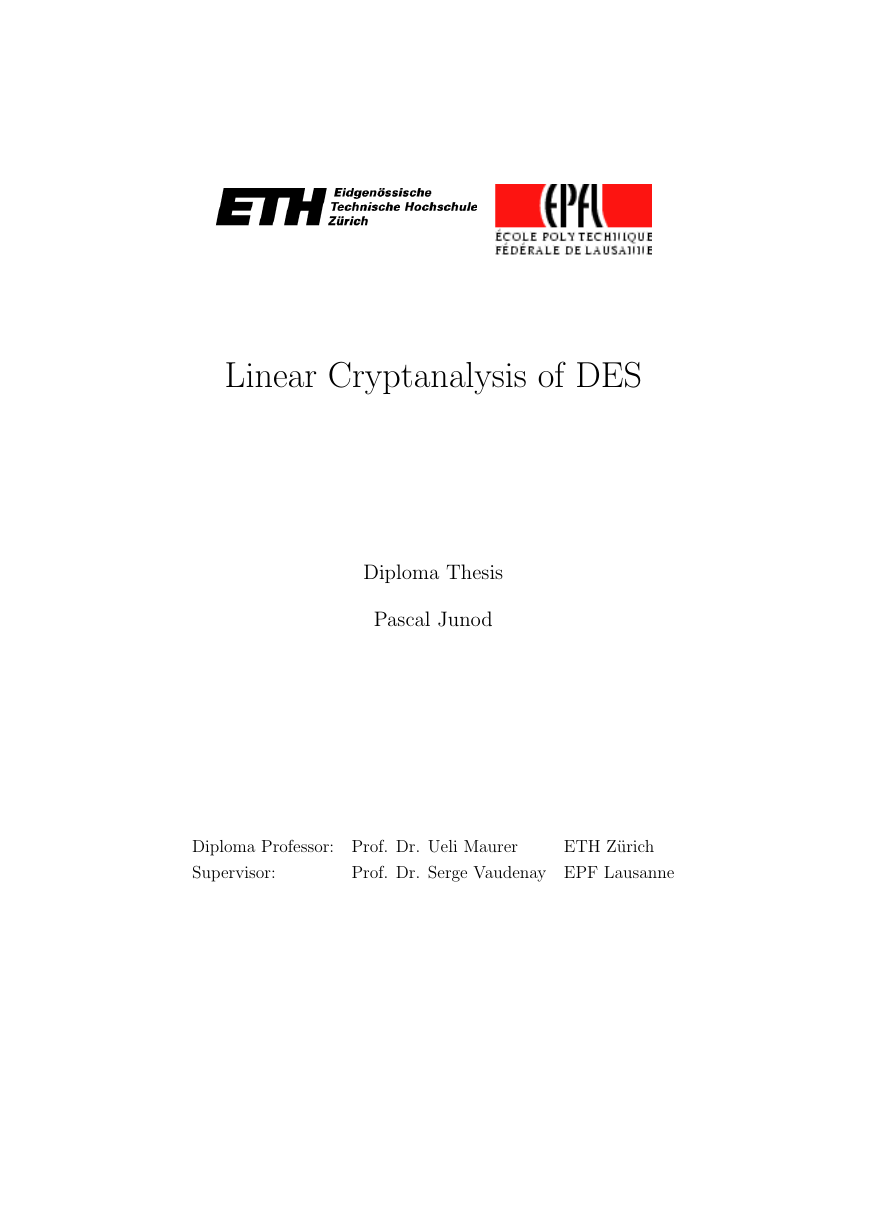

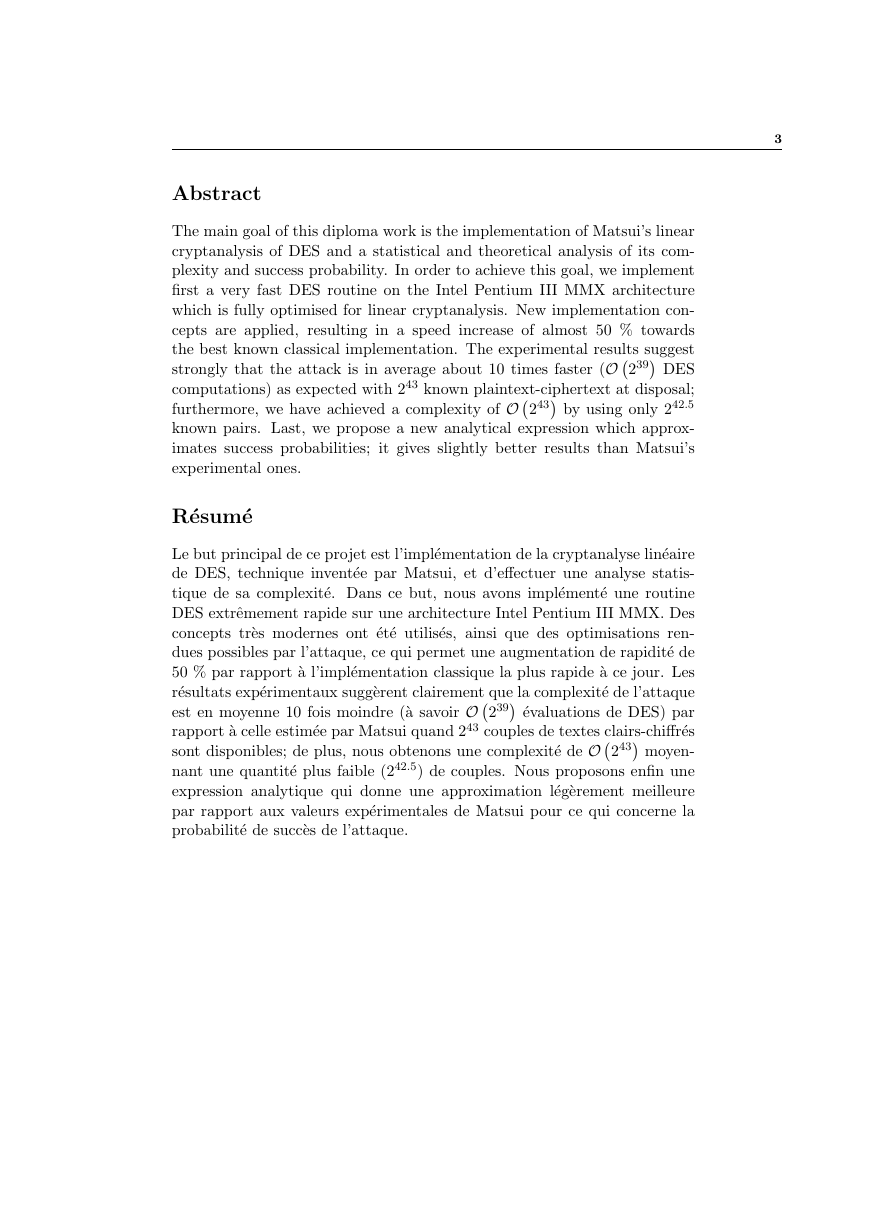
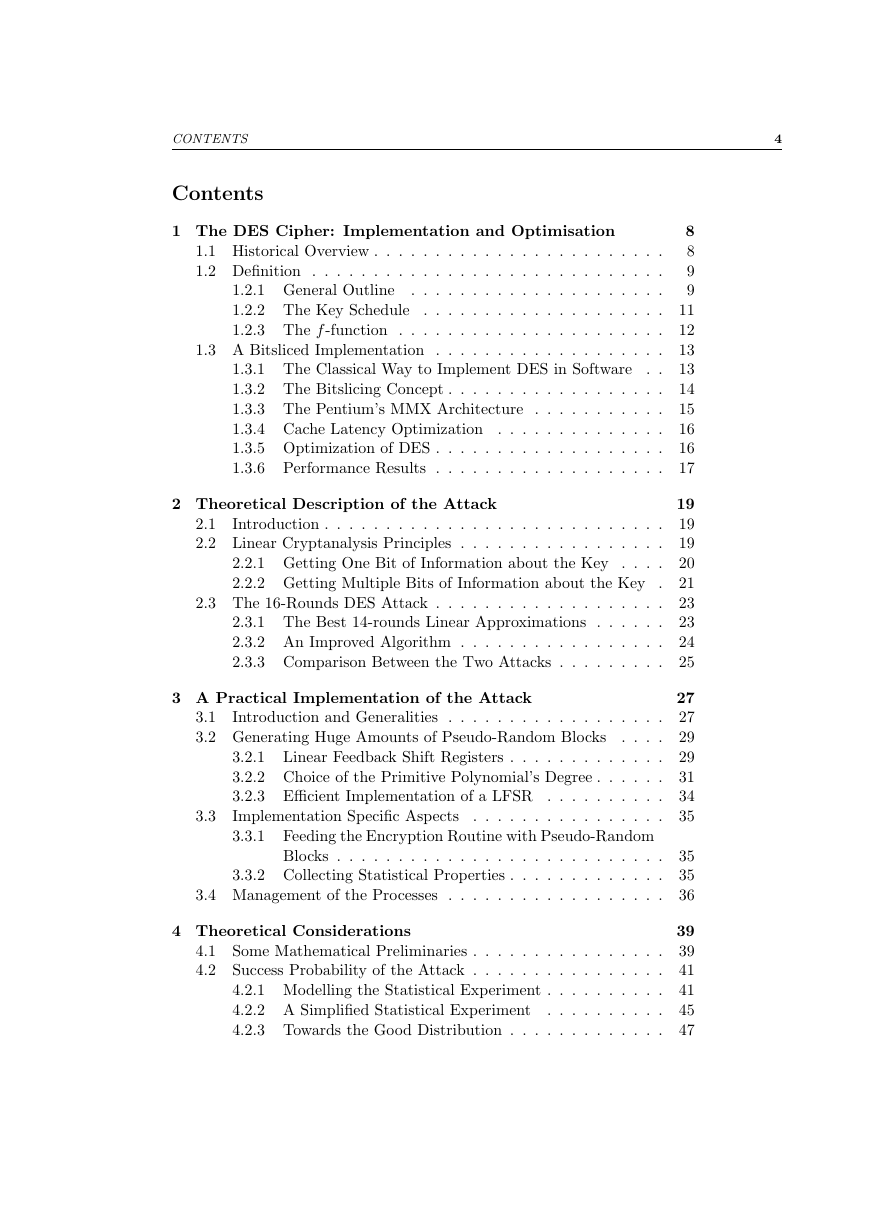
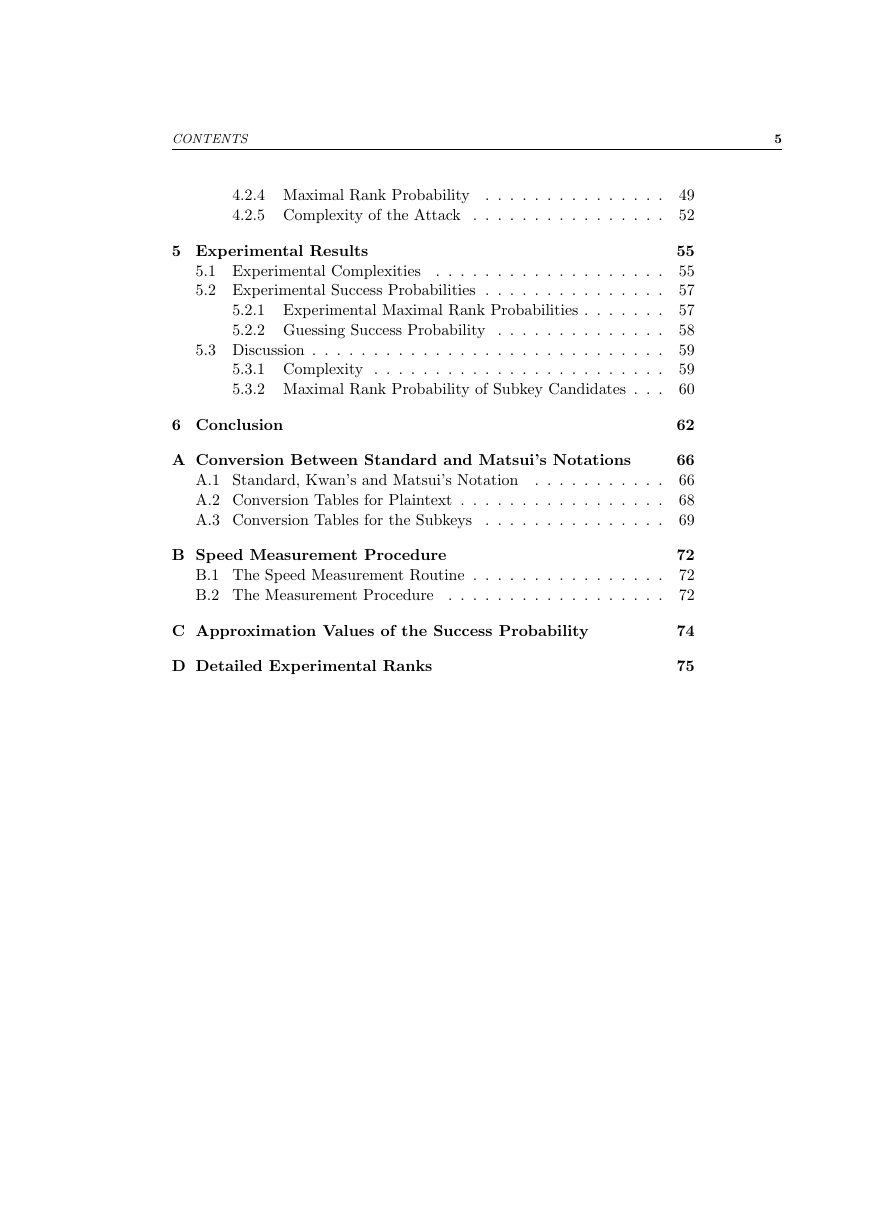

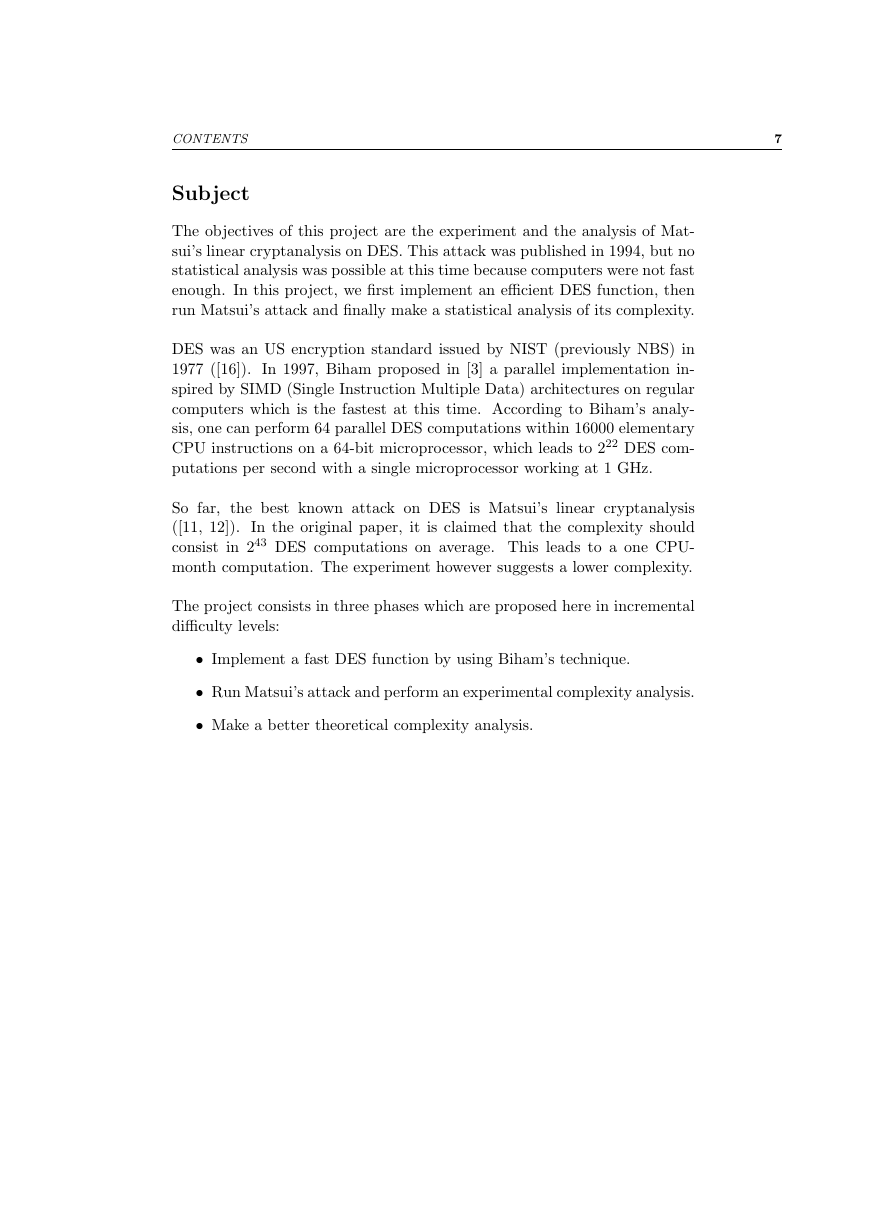
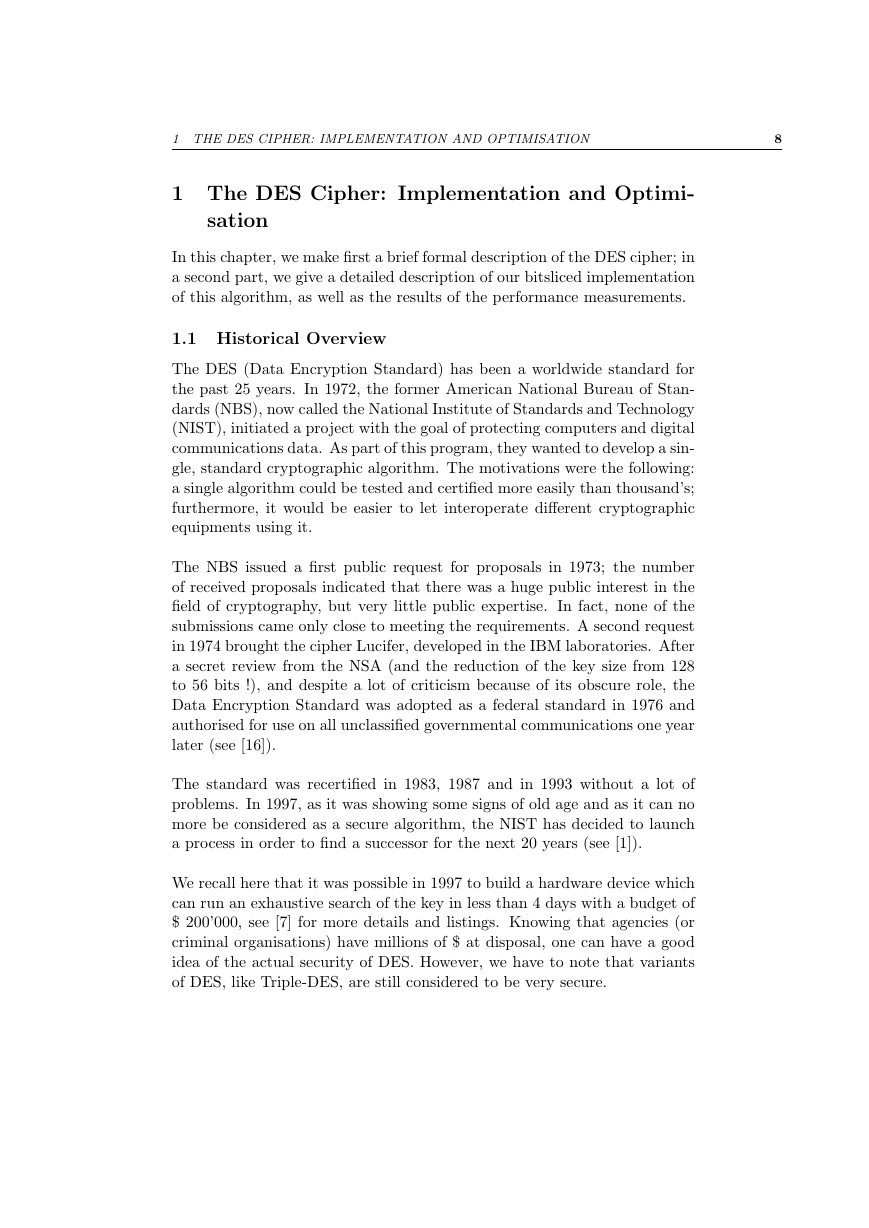








 2023年江西萍乡中考道德与法治真题及答案.doc
2023年江西萍乡中考道德与法治真题及答案.doc 2012年重庆南川中考生物真题及答案.doc
2012年重庆南川中考生物真题及答案.doc 2013年江西师范大学地理学综合及文艺理论基础考研真题.doc
2013年江西师范大学地理学综合及文艺理论基础考研真题.doc 2020年四川甘孜小升初语文真题及答案I卷.doc
2020年四川甘孜小升初语文真题及答案I卷.doc 2020年注册岩土工程师专业基础考试真题及答案.doc
2020年注册岩土工程师专业基础考试真题及答案.doc 2023-2024学年福建省厦门市九年级上学期数学月考试题及答案.doc
2023-2024学年福建省厦门市九年级上学期数学月考试题及答案.doc 2021-2022学年辽宁省沈阳市大东区九年级上学期语文期末试题及答案.doc
2021-2022学年辽宁省沈阳市大东区九年级上学期语文期末试题及答案.doc 2022-2023学年北京东城区初三第一学期物理期末试卷及答案.doc
2022-2023学年北京东城区初三第一学期物理期末试卷及答案.doc 2018上半年江西教师资格初中地理学科知识与教学能力真题及答案.doc
2018上半年江西教师资格初中地理学科知识与教学能力真题及答案.doc 2012年河北国家公务员申论考试真题及答案-省级.doc
2012年河北国家公务员申论考试真题及答案-省级.doc 2020-2021学年江苏省扬州市江都区邵樊片九年级上学期数学第一次质量检测试题及答案.doc
2020-2021学年江苏省扬州市江都区邵樊片九年级上学期数学第一次质量检测试题及答案.doc 2022下半年黑龙江教师资格证中学综合素质真题及答案.doc
2022下半年黑龙江教师资格证中学综合素质真题及答案.doc